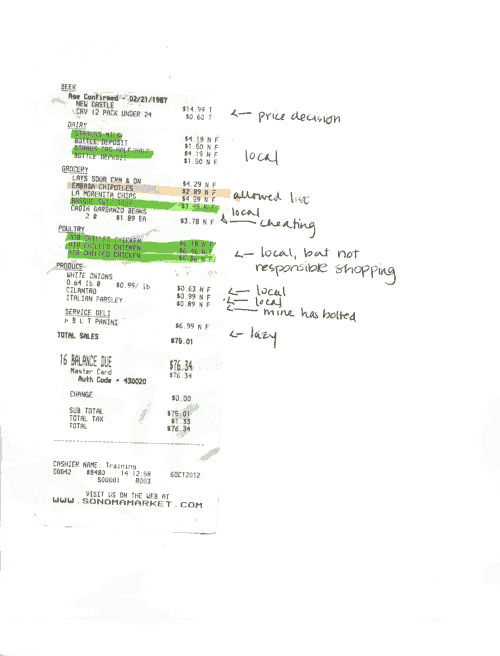Last updated on February 7th, 2013 at 04:01 pm
The first step on the road to achieving any dream is to know what you’re dealing with.
Many a dream has been delayed or waylaid by ignorance. What kind of ignorance? Why, not knowing who you are as a person, and where your strengths and weaknesses are, as well as what your habits and preferences are. In the context of bagging the supermarket, this comes under the rubric of Shopper, Know Thyself.
For the first week or so, don’t change a thing. Just hang on to your grocery receipts. Now, some people are weekly shoppers. Some people (like me) are daily shoppers. And there’s probably everything in between. If you’re a weekly shopper, you might want to collect two grocery receipts. If you’re a daily shopper, you might only need five days’ worth.
Once you have your receipts, get out some tape and your journal. All you dreamers have journals, right? Of course you do! Tape your receipts into your journal, one to a page. Then get out a pen, or some highlighters, or some colored pencils, and set to work analyzing your receipts.
One of my daily receipts is shown at the top of this post. I was shopping for a little dinner party, but I tend to have a little dinner party every week or two, so it’s a legitimate example. You can see that I’ve made some commentary for myself; it’s a mini-journal entry of my trip to the grocery store.
On a typical receipt, processed food could be one category.
Another could be fresh produce. Yet another one would be non-food items, like dishwasher soap and paper towels. You could have a category for meat, for dairy, for snacks. It might take you a couple of sessions of analyzing your receipts before you start to see your patterns clearly enough to set up your categories.
Personally, I don’t spend a lot of time on non-food items. I figure things like dish soap, laundry detergent, toothpaste, and paper towels are not terribly available from local sources. One of these days, I’ll write a post about substituting for some of those things, but for now, let’s focus on the food items.
Next, look to see what is locally produced on your receipt and what is not. On my receipt, the milk and half and half are local, and so is all the produce. I got a little defensive about the parsley, because I grow it, but my parsley has bolted for the season so I had to buy some. The item listed as Basque SWT/Sour is local sourdough bread. The chicken is local. The chips are not, nor is the can of chipotles in adobo sauce, nor the two cans of garbanzo beans. The sandwich is pretty much local, but as you can see, I marked it “lazy.” I can make a sandwich. I shouldn’t be buying one.
I’ve been on the local bandwagon for awhile, so this particular receipt is not too bad. But it certainly has room for improvement. I’m at the point where buying chicken parts is not something I feel okay about. I should be buying whole chickens and cutting them up, not buying pre-packaged thighs. My mother taught me to cut up whole chickens when I was just a little whippersnapper, so not to do that is just plain lazy, costs more money, and isn’t very responsible. After all, chickens don’t come thighs-only.
And as a matter of fact, this morning, when I was coming down with a case of the flu, Virgo Man warmed up some chicken broth for me. It was the packaged broth I cook with at least twice a week, and tasting it on its own demonstrated to me that it tastes absolutely dreadful. It reminded me that whatever parts of a chicken I’m not going to cook for dinner need to go in the stock pot, and the stock needs to go into the freezer. It’s dumb for me to buy chicken thighs in a package instead of whole chickens, when I have a legitimate use for all the chicken parts, even the backbone and the neck.
But I digress. Let’s get back to the analysis.
While you’re doing your analysis, be mindful of what you are currently spending, too. Be aware that shopping locally and reducing your intake of processed food will cost you more money at first. You can mitigate the extra expense, but I’ll save that for a future post. For now, you’ll want to ask yourself what you would have to change in order to commit to local food, and whether you’re willing to do that. For my family, for example, meat has to be a much smaller proportion of our diet, because it’s about 3 times as expensive when I buy it locally. Also I have to use a lot more ground meat than I’m used to, because it’s less expensive and goes farther. I’m happy to do that, but your mileage may vary.
After you’ve done your categorizing, give yourself some time to ponder. What are your local options for things you’ve bought that are not local? Are you buying any out of season fruits and vegetables? Do they taste good to you, or it is just habit? And what about snack foods…those potato chips are relatively cheap and easy. What’s going to take their place, if anything?Is there anything that is not local that you would put on an allowed list, because you can’t get it locally?
On my allowed list, for example, I have coffee, chipotles in adobo, and avocados. Also condiments, like ketchup and mayo (although I’m working on that one). I’m sure there’s some other stuff too, but those are the absolutes I can think of right now.
When you get to the end of this analysis, you’ll have a good handle on your food buying habits. You’ll have thought about whether some of those habits should change, and whether some of them should stay steady. You’ll be thinking consciously about how you spend your grocery money. Personally, my advice would be to start with milk and eggs. They are so astonishingly different from industrial milk and eggs that they’ll make you a believer and inspire your next steps.
But for now, just knowing where you stand is a great first step.
Jayne

Enjoy this special 8WomenDream Guest Contributor story submitted by new and experienced big dreamers throughout the world, edited and published to capture a dream perspective from different points of view. Do you have a personal dream story to share with 8WomenDream readers? Click here to learn how to submit dream big articles for consideration.
Note: Articles by Guest Post Contributors may contain affiliate links and may be compensated if you make a purchase after clicking on an affiliate link.





